It’s a little after 1.30am. Time for the earliest breakfast of my life: noodles and coffee, at a shanty style café that’s one of only three small buildings with lights glowing, at the edge of a forest clearing on the inky black slopes of Ijen volcano, east Java.
Others are eating, too, including a small band of intrepid travellers from nearby Surabaya. They’re well wrapped against the mountain chill, and chat excitedly about the climb ahead.
Looking back, I see a man passing in the darkness. He walks swiftly, purposefully past, oblivious to the small breakfast crowd. There’s no time for registering details beyond the glow of a cigarette, and large baskets balanced on his shoulders, as he vanishes into the night. Yet I’m thrilled to see him.
He’s a sulphur miner. One of a rare band of men who harvest sulphur from within the crater of Ijen. I’ve read of the miners, seen photos of them toiling amidst sulphurous fumes and heat. Yet I had never really expected to visit this place, and see them at work.
Recently, I’ve also been told that at night, blue flames of burning sulphur can be seen in the crater. This sounds an otherworldly sight, but if I can reach the rim by dawn, maybe I can peer down to glimpse the flames.
The Ijen volcano complex dominates the landscape of easternmost Java. There are several volcanic cones, rising to 2799 metres. Active craters include Ijen, which for decades has been mined for its sulphur.
Sulphur is a bright yellow element that is common in volcanic gases. During the Industrial Revolution, sulphur demand soared, especially as it was used to make gunpowder. This in turn led to extensive sulphur mining in Sicily, southern Italy, first by digging from open ground, then by tunnelling in hot, hazardous conditions. Sulphur mining has occurred elsewhere, such as a volcanic island in New Zealand, and high in the Andes. Yet nowadays sulphur is a by-product of oil refining and other industries, an Andean operation is mechanised, and only in Indonesia is sulphur still mined by hand.
At one Javan volcano, miners dig sulphur from the slopes, then trundle it downhill on roughly built wooden wheelbarrows. Here at Ijen, there were attempts to use horses for transporting the sulphur loads, but the terrain was too tough for them, so miners not only extract sulphur, but also carry it downhill in bamboo baskets.
Starting up the path towards the crater, I find it is wider than I expected, like a narrow dirt road of compacted black stones and soil. It winds steeply upwards, and to left and right my torch beam picks out bushes and tall trees. At times, there are the first scents of Ijen sulphur – faint yet foul aromas of hydrogen sulphide, the classic gas of rotten eggs.
The path reaches a wooden hut – a weigh station, where miners check how much they are carrying. It’s quiet now, though one miner is resting, and offers sulphur souvenirs for sale.
The path is narrower from here, climbing a steeper slope. In places, there are steep drop offs to the darkness on the right. My torchlight reveals the vegetation is lower, with trees more stunted. Then, there are no trees at all, just skeletal remains of shrubs, surely telling of an event when an outpouring of toxic gas killed plant life. The sulphurous smell is stronger now, and the path makes for the rim of the crater.
There are no plants here, only stones and rocks underfoot. The crater lies below, a gaping black hole. There are stars above, lights of a distant town visible way down and beyond the volcano. But looking into the crater and hoping to see it dotted with blue flames, I’m disappointed to find nothing but blackness.
People are walking onwards along the top of the rim, so I follow, and a rough trail leads to what seems like a rocky spur jutting out towards the crater. It ends at a vantage looking almost vertically down. And there, shining brightly below, are the blue flames of Ijen.
I rest, take photos, admire the scene, which is indeed otherworldly. Deep in the crater, close together, are three or four patches of blue flames, with what seems like smoke around and above them, sometimes swirling to obscure the eerie fires. There are patches of light moving too, from torches of miners and visitors roaming near the fires.
“Do you want to go down?” asks a man who has been waiting by the path. He’s a sulphur miner, and talks in Indonesian that’s translated for me, offering to show me the way down, close to the fires some 200 metres below. The trail from here looks steep, rocky, and scary. But I soon say yes, and follow my guide down, into the crater.
The path twists and turns downwards, across small crags, and plunging slopes of loose stones. Some years ago, a tourist fell to his death here, and I walk slowly, careful not to slip on a loose stone. The stench of rotten eggs becomes more intense, and there’s another, acrid odour – sulphur dioxide, which is likewise toxic. I pull one a paper face mask my guide has given me.
Even though it’s only around 4am, there are some visitors making the return trip up the trail. “It’s a tough climb – but worth it,” an Australian guy tells me. There are miners, too, and I stop to give them space as they slowly ascend, each heaving two baskets filled with chunks of sulphur, slung from a pole supported on a shoulder.
Some miners are resting, too, with baskets placed on rocks that must serve as regular stopping places. It can take each miner well over an hour to reach the crater rim. Yet even this pace is astonishingly fast given their loads may weigh around 70kg. That’s the same as, for instance, 70 one-litre cartons of milk. Imagine carrying that kind of weight any distance, even in a hi-tech backpack and over level ground, never mind in two baskets balanced on a pole and up a rock face.
The slope eases at the bottom of the crater wall, and we walk to a stony ridge, where some local tourists have gathered. This is like a viewing gallery for watching miners at work just tens of metres away.
It’s still pitch black. Yet there are lights, especially the waving, shimmering, weirdly wonderful blue flames. There are patches of flame on what looks like a living, steaming hillside. Steam is blasting out all around the flames, then surging upwards to form a great column that disappears into the night sky above. There’s a continuous roaring sound, like a giant furnace.
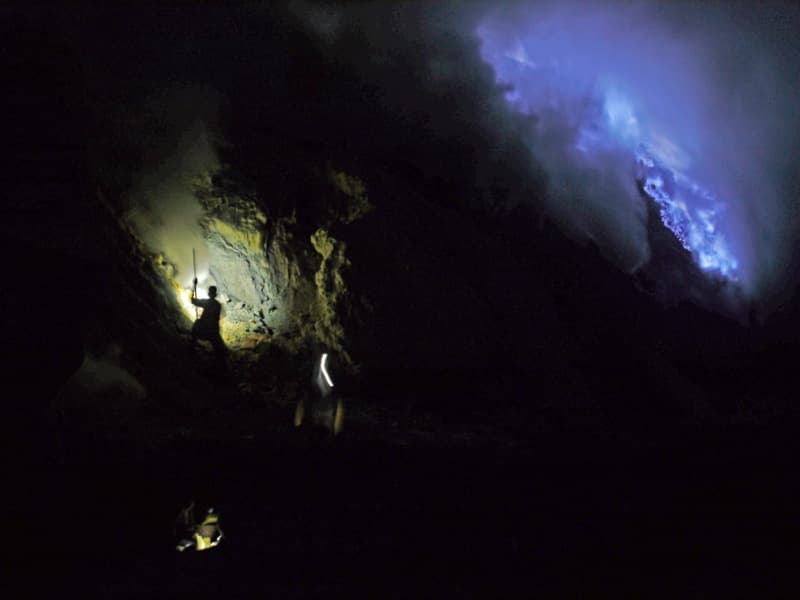
The Bible’s horrors of “Fire and brimstone” may have originated with volcanoes, as brimstone is an old name for sulphur, which is characteristic of the brims of volcanoes. But forget images of tormented souls amidst orange fires. As a friend later notes, “Hell is blue”.
Miners carry lights too, including head-mounted torches they use to locate fresh sulphur deposits, which they smash and prise from the rock surface using metal poles. Around eight miners are at work in front of us, moving below the sulphurous steam. One wears a gas mask, but others just use pieces of cloth over their mouths, or no protection at all. Unsurprisingly, working surrounded by toxic fumes and carrying heavy burdens takes a severe toll on their health, and I read of sulphur miners’ life expectancy being just 30. This figure seems too low to me, as I see miners who are clearly older, but few will reach what most of us would consider a ripe old age.
As daylight creeps into the crater, I see rows of pipes running down the steaming slope. These are ceramic, and the miners installed them to capture gases emerging from fumaroles, and guide them downwards so they cool a little, allowing sulphur to condense and trickle to collection points. It’s astonishing to see these pipes, which have been placed here even though gases from fumaroles can reach 600˚C, and molten sulphur is at least 115˚C.
We move further down, and are soon at a working area beneath the surging steam. The ground underfoot is yellow with sulphur powder. Men are moving between sulphur collection points, where intensely red liquid sulphur drips from pipes, and turns yellow as it solidifies. Some are breaking it with the rods, gathering chunks; others pick up sulphur fragments.
My guide – who usually works down here, ensuring production remains good – fills small moulds with liquid sulphur, to make souvenirs that miners offer visitors: a crab, a turtle and a cat.
At first, I’m wary of approaching the dripping pipes, as the sulphurous steam is surging close overhead, But it seems relatively constant today – blasted almost horizontally from the slopes just above, then rising in a white column that rises far above the crater rim. So I walk in nearer, till I’m in a band of clear air with steam at little more than head height, and molten sulphur a couple of steps away. Later, I learn that I’m lucky with conditions today, as I come across a video showing a BBC television crew who were often enveloped in sulphurous gases, with the acids soon stopping all their camera gear working.
There’s acid below me, too, in a sullen green crater lake. Thanks to a remarkably concentrated mix of sulphuric and hydrochloric acids, its water is the strength of battery acid. Almost 200 metres deep, a kilometre wide, and with a volume of 3 million cubic metres – equivalent to over a thousand Olympic-size swimming pools – it is the world’s largest acidic lake. Though tranquil now, the lake can be deadly. In 1817, the lake collapsed and mudflows destroyed three villages. In 1976, a sudden release of gas from the lake killed 11 miners.
We return to the crater rim, where before saying goodbye, my guide tells a little of the miners’ lives. Around 400 men work at the mine. “Most carry 70kg of sulphur, twice a day,” he says. For this, they earn around HK$80 – double the amount labourers make in nearby coffee plantations. “For working on production, I earn a small salary, but it’s not enough to support my family, so I usually also carry sulphur with me as I leave.”
Now we’re out of the crater, I notice my guide is short, perhaps as the heavy loads have impacted his spine. He pulls his shirt collar down, revealing rough red patches on a shoulder worn by the pole between the baskets. Yet he is smiling as we part; life does not have him beaten.

There’s superb scenery as we walk down, with two nearby volcanic cones, forested hillsides, a plain below. This surely means nothing to the miners as they head down with their loads. The path is often steep, with small stones making it easy for me to slip. Yet the miners are sure-footed, taking short quick steps as they move. Often, they’re moving at almost jogging pace, and at intervals dip a little beneath the baskets, using swift hand movements to switch the shoulder the pole is resting on.
Even the miners’ footwear is rudimentary. Some are in little more than basic sandals. One resting miner has removed a short rubber boot, revealing a foot wrapped in rags; I shudder inwardly with thoughts of sores and welts on his feet. Each halts at the hut with the weighing station, to check how much sulphur he is carrying, and probably smoke a cigarette before heading down again.
At the bottom of the path – 3km from the rim – the miners at last reach their destination. This is the official weighing station, run by a nearby sugar refinery that oversees the mining operation. Here, each miner watches as his load is weighed, and money owed is calculated. There must be 30 or more miners gathered as I arrive, mostly sitting or standing around, almost too exhausted to talk.
The sulphur is then piled into a waiting truck, which will take it to a simple factory where it will be melted and cooled in a refining process. Then, this Ijen sulphur may be used to make sulphur dioxide for whitening sugar.
For me, a trip to Bali awaits, and then back to Hong Kong. Yet the miners will be returning to the crater during the night, and aiming to make a second trip before the midday heat makes the trip too unbearable even for these astonishingly tough men of Ijen.
Indonesia travel articles
Spectacular southern Java including Geopark
Mention to a Hongkonger that you’re going on holiday to Indonesia and they may ask, “Bali?” Yet there is far more…
Seram and Haruku, South Maluku: The Islands Where Birds Colour the World
There are resorts that might be described as “Away from it all” when, truth be told, they’re little more than just…
To the Spice Islands of Wallacea, eastern Indonesia
Approaching Ternate from the air, I see a volcano rising from tropical blue sea, with green slopes, clusters of small houses…
Javan Jungles inc Gunung Halimun and Ujung Kulon Indonesia
Though Java is the world’s most populous island, there are remote forest areas with wildlife including rare species like gibbons and…
Forest Conservation in Kalimantan, Indonesian Borneo
I’m travelling to meet people working to save the remaining forests of Borneo, which was described Charles Darwin as, “One great…

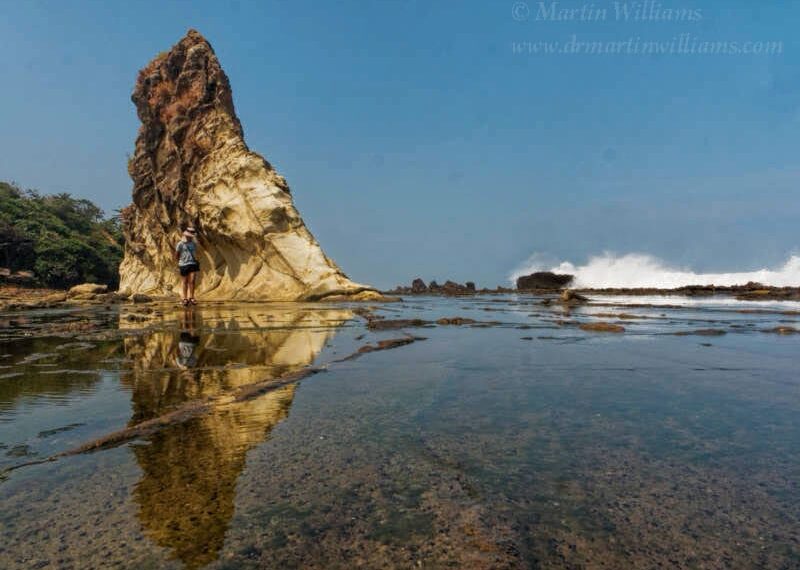
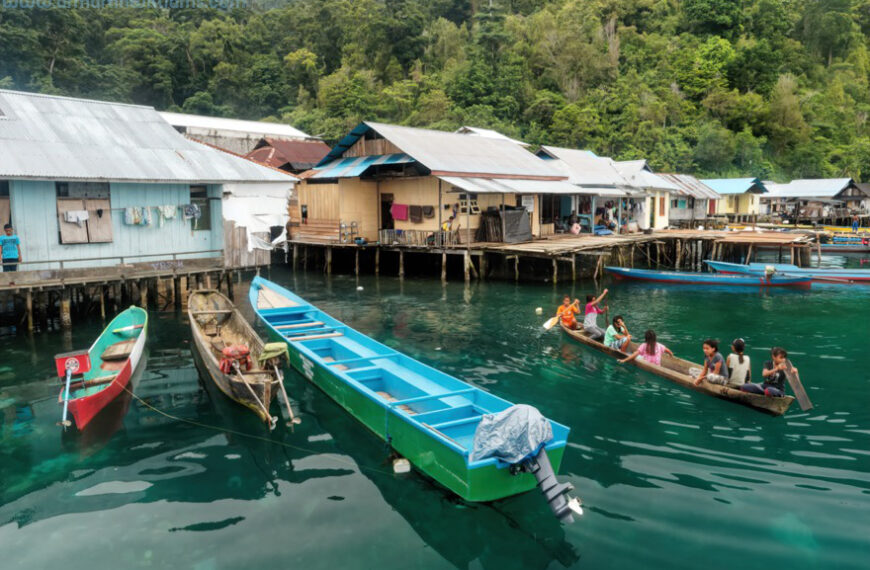
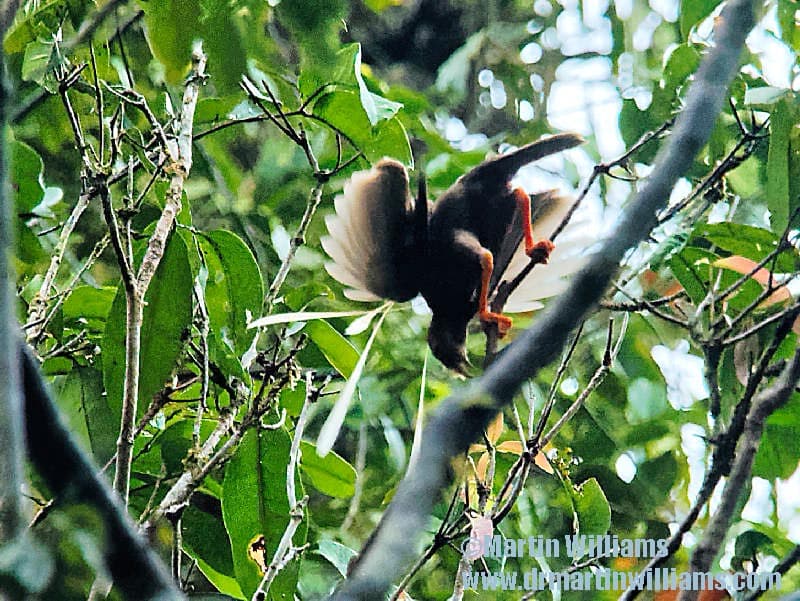
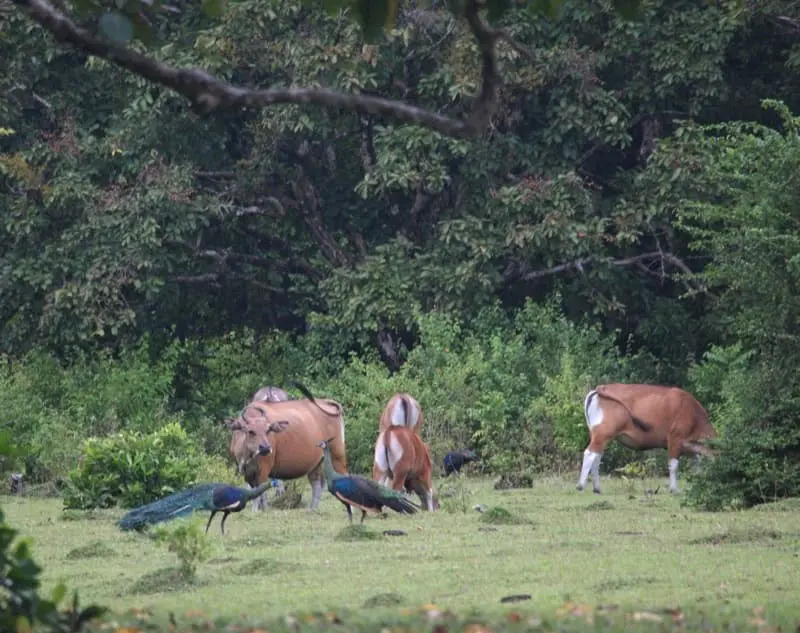
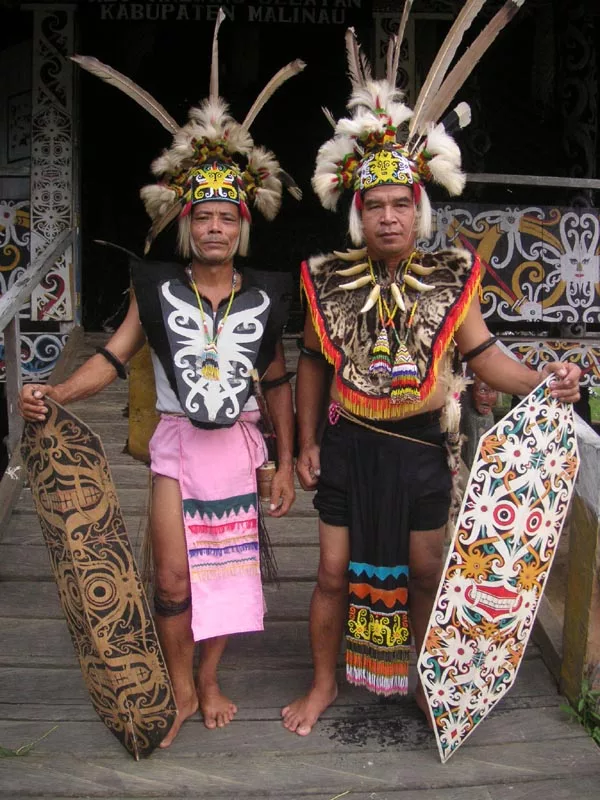
Swiss guy helping Kawah Ijen miners
See also re Swiss guy helping miners, including by supporting education for kids, and arranging for specially designed hand carts to help get the loads down from crater rim:
http://www.scmp.com/lifestyle/travel-leisure/article/1857343/swiss-inspiration-thats-changed-lives-sulphur-porters-java